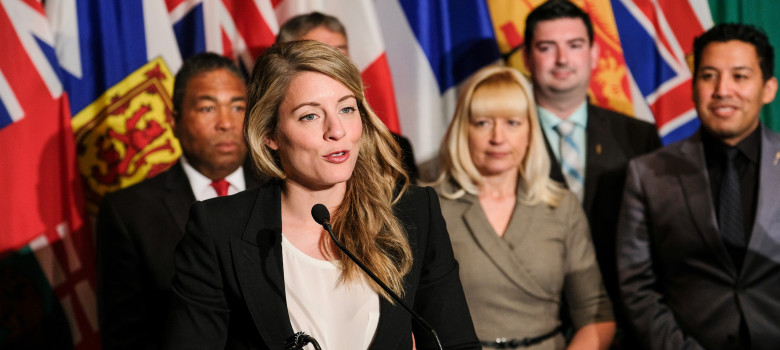Canadian Heritage Minister Melanie Joly launched the next phase of her consultation on supporting Canadian content in a digital world this morning, but the results from the first “pre-consultation” phase – an online poll of the public and stakeholders – already points to the policy challenge faced by the government. The poll received more than 10,000 responses with participants asked to identify the major barriers and challenges for Canadian content. The perspective of the public and stakeholders (I place “stakeholders” in quotation marks in the title because all Canadian stakeholders) are strikingly different, with the public citing the challenges in finding and promoting content and the stakeholders seeking more money.
For example, the survey asked participants to identify “the most urgent challenges facing the culture sector in the creation, discovery and export of Canadian content in a digital world.” The top answer for the public was foreign competition and making content stand out online. In other words, the public says there is an incredible array of choice led by large foreign providers and that finding Canadian content is not easy. Industry stakeholders do not see it that way, however. Their top challenge – by far – was creator remuneration followed by how public funding is allocated. Foreign competition and making content stand out online rank further down the list.
The divide is similarly apparent when asked about the most urgent barriers. The public says there isn’t enough quality content produced. Stakeholders blame everyone else – their top two barriers are consumers (who they say expect free or low cost content) and the government (they say their programs have not kept pace).
Given these views, the proposed solutions also diverge significantly. The public says the most effective tool to address the issue better efforts to promote and brand Canada abroad. Stakeholders want more money as “enhanced public support for creators” and “direct government support to creative industries” – both essentially more tax dollars for the industry – rank as the top two solutions.
Joly’s latest consultation talks about looking confidently to the future and rightly notes that “the way forward is not attempting to regulate content on the Internet.” The public seems largely on board as their responses focus on the need to better promote Canadian content so that it is easier to find. The industry, on the other hand, seems content to use the consultation to seek more public funding, suggesting that the technologies may have changed, but using the policy process to lobby for more tax dollars remains the same.








And nobody was surprised at all. I swear, Canadian content creators churn out crap just to get the subsidies. How can we be so close to the Americans, and have watched their media grow for decades, and not learn a thing or two about how to create compelling entertainment???
The Stakeholders can’t even come up with creative answers to a poll, how can they ever be expected to come up with creative solutions to the actual problems? They don’t know how to create, just collect $.
Canadian content needs to be discoverable and also needs to be good to compete. I look forward to the day when the people who created utter shite like Corner Gas and that horrible show about the Mosque are out of work.
Angry much? Corner Gas is quite popular, even south of the border. I suggest you show us what you’ve contributed, culturally, artistically, or financially to Canadian Arts? Oh, right…nothing. Carry on.
No, no it’s not, he is right, it was complete shite and simply a welfare check to these bums who try to dictate what we will watch come hell or high water and most people are sick of it and this is exactly why people are cutting cable and choosing to watch outside the limits that are forced on a lot of Canadians.
Let me guess, it was your idea all Canadians should watch this garbage.
Agreed.
Canadian content providers are basically the Uwe Bowl of NA. They produce crap to get money from the gouvernement. Where are the space operas, the interesting shows, the mysteries, the thrillers?
Why is Canadian content basically just crappy talk shows, game shows, reality TV or boring drama?
Radio Canada and quebec actually put out some very good content. 19-2 was brilliant and on par with many American cop shows. Radio canada has also had online access for many years now and developed their tout.TV platform which made it very successful and easy to watch.
The closest I saw on cbc that I enjoyed that much is Cracked, which was already cancelled by the time I discovered it on Netflix.
Also we have the talent. Look at how many “American” shows are filmed in bc.
I’m with the consumers on this one. I want to see more canadian content, I just don’t want to see it enough to create a schedule around their air time.
There’s good Canadian content, of course. One problem is that the major producers here keep looking up to the US producers as being the ultimate. Another problem is that they come from a perspective of “ratings” and that can only lead to a lack of identity. They start off from a perspective of considering themselves second best.